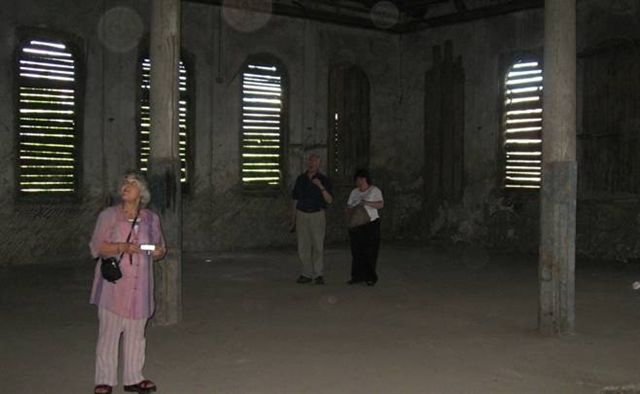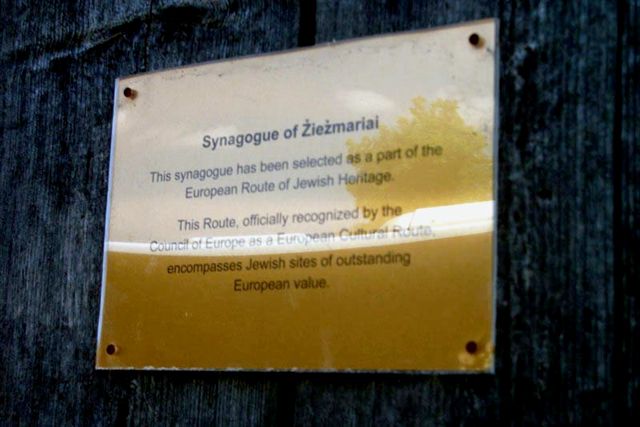 Alternate names: Žiežmariai [Lith], Zhizhmory [Rus], Zhezmir [Yid], Żyżmory [Pol], Žižmariai, Žiežmarių, Zhizhmory, Zhiyezhmaryai, Zhezhmaryay, Žeižmariai, Zhezhmir, Жижморы. 54°48' N, 24°27' E, 22 miles WNW of Trakai (Troki). 1900 Jewish population:1,628.
Alternate names: Žiežmariai [Lith], Zhizhmory [Rus], Zhezmir [Yid], Żyżmory [Pol], Žižmariai, Žiežmarių, Zhizhmory, Zhiyezhmaryai, Zhezhmaryay, Žeižmariai, Zhezhmir, Жижморы. 54°48' N, 24°27' E, 22 miles WNW of Trakai (Troki). 1900 Jewish population:1,628.
The Jewish community in Žiežmariai existed since the mid-18th century. Prior to WWI, around 700 Jews lived in Žiežmariai. Some Jews emigrated to the USA, Uruguay and Palestine in the inter-war period. On the eve of WWII, about 200 Jewish families resided in the town engaged in crafts, commerce, vegetable agriculture, and fishing. Under independent Lithuania, the local Jewish community had its own bank, a school with instruction was Hebrew, a library, drama studio and an orphanage. [March 2009]
CEMETERY: information. [September 2010]
MASS GRAVE: Forest of Strosiunai, Ziemariai county (two massacre sites); 92-93; pic. # 89-90. source: US Commission for the Preservation of America's Heritage Abroad. US Commission for the Preservation of America's Heritage Abroad
On the first weeks of the Nazi occupation, legal discrimination of Jews began. On July 5, the governor of Trakai District instructed the rural districts chiefs to order the Jewish communities to elect Jewish Councils and elect a chairman and deputy. Preparations for killing the Jews started in the mid-August. Local policemen and white-bands arrested about 150 Jewish women with children and placed them in the Kaišiadorys synagogue. The next day, they were driven to the forest several kilometers from Žiežmariai and executed on the Triliškiai estate. 282 Jewish men and women in Žiežmariai delivered to the Kaišiadorys ghetto were shot on August 26-27. German soldiers arriving from Kaišiadorys shot 70-80 Rumšiškes Jews on August 29 and possibly Žiežmariai Jews because once the 282 Jews from Žiežmariai were sent to Kaišiadorys Ghetto, 200-250 Jewish women and children still remained in the town. On August 31, no Jews remained in Kaišiadorys, Žasliai and Žiežmariai. Belongings of the murdered Jews were brought to Žiežmariai synagogue where a special commission distributed their property among the Lithuanians of the town. Execution of these Jews did not end the Jewish presence in Žiežmariai since Jewish labor camp in Žiežmariai was established in the Spring 1943, when the ghettos in Švenčionys, Ašmena and Michališkes were liquidated. About 1,500 prisoners from Ašmena Ghetto were transferred to the labor camps in Žasliai, Žiežmariai, Kena, and Naujoji Vilnia. About 1,000 Jews worked at Žiežmariai Camp on Vilnius-Kaunas highway. Men and women, old people, and children were forced to work with little food, bedding, and medication. Contagious diseases spread. In May 1943, the Nazis liquidated the Žiežmariai ghetto with part of the inmates transferred to Pskov Region near the frontline and another 400 to Kaunas ghetto. On June 6, 1943, 680 were delivered to Kaunas ghetto at the former "Lituanika" cinema and the synagogue on Miškinio Street. Another 140 skilled Jewish professionals stayed in Žiežmariai, however, no information is available about their fate. The precise date of liquidation of Žiežmariai labor camp is unknown.In 1941 in Trakai (excluding Eišiškes Rural District, which became a district in 1942) at least 4,319 Jews were killed, almost the number of the Jews who resided in Trakai District (4,305 persons). With the 3,446 Jews killed in Eišiškes, the number of the Jews executed in Trakai District was 7,765 persons. [March 2009]
Photo courtesy Merle Kastner [June 2015]
[UPDATE] Kehilalink [January 2016]




